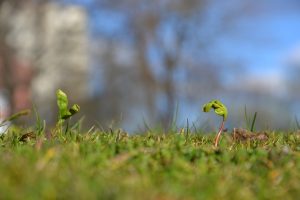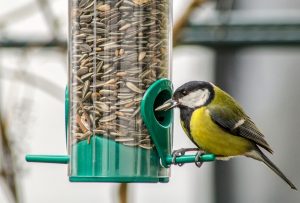Feeding visiting garden birds is a rewarding and fun activity, but, it might create more work if you don’t plan ahead.
I’ve prepared a guide on how to stop birdseed from germinating beneath feeders.
If you think smart and plan, it is possible to avoid any additional weeding.
The positioning of hanging bird feeders, the ground covering beneath the feeders, and the type of seed used are all contributing factors in operation Sprouting Seed Prevention!
Table of Contents
Does spilt birdseed grow into weeds?
I think the best definition of a weed is something that grows at will where it isn’t supposed to be. Beauty is in the eye of the beholder and if it grows, and you like it, keep it.
Birdseed grows into whatever type of seed you use for feeding. Sunflowers, millet, wheat, flax, and rapeseed are the most common types. In the UK, nyjer seed flowers as pretty purple thistle-like flowers that finches adore.

At the first stage of germination, they all look similar to shoots of grass.
This is the time when it is easiest to pull them out before they have grown a strong root.
Alternatively, if your bird table is in a previously bare section of garden or at the edge of a lawn, what better idea than to grow a wild section of the garden. Not only will you be feeding the birds, but also providing a lovely space for the bees and butterflies.
Seed catchers
One of the cheapest and most effective ways of stopping errant birdseed from being thrown on the ground is to attach a catcher tray beneath the feeder.
If you have a pole feeder with multiple hanging feeders, an inexpensive plastic tray does the job. I bought a tray from a pound store, drill a pole-sized hole in the centre, and slotted it up the pole. I secured it in place with a jubilee clip and bingo; it catches most of the seed from all of the feeders.
Individual feeders with attached seed catchers are a good investment.
Keep the area clean
A quick daily rake or sweep of the ground removes the seed before it has time to sprout.
Rely on our ground-feeding friends to clean up
Not all birds like to eat from hanging bird feeders or tables; some prefer to eat from the ground. Clever chaffinches, blackbirds, and house sparrows know to forage beneath feeding stations to find any discarded seeds.
Pigeons are also good at clearing up after messy eaters but you should be aware, they might also dine on newly planted grass seed.
Stabilise your feeders
It might not be the feeding birds that are discarding the seed; the wind sometimes causes the feeders around.
Anchor them to the branch or bracket with a piece of twine. Not only might you notice less scattered seed, but it also provides a more stable experience for the birds.
Seed proof the area beneath the feeders
Seeds can only germinate if they fall into areas of bare soil such as garden borders, or onto the lawn when there is enough space, light, and moisture.
If seeds regularly sprout, you need to change the surface conditions around the feeding areas.

- Flagstones and pavers around the base of feeding stations tidy the area up and make it easier to sweep up any debris.
- Cover the area with a weed suppressant membrane and a thick layer of large gravel. Small pea gravel isn’t sufficient; the shoots manage to grow through that.
- Plant lots of dense ground covering plants beneath the feeders. Geraniums are ideal at preventing the seeds from getting through to the soil.
Rethink your bird feeding routine
Don’t overfill the feeders; the fresh seed is more appetising to the birds. They might be tempted to toss stale seed across your garden.
Avoid cheap seed mixes; they are cheap for a reason; filled with less popular seeds that the birds ignore or throw from the feeders.
Only feed what the birds like; find the most popular seeds in your garden and stick to those. That way, the likelihood of them eating everything is increased.
Can birdseed be sterilised?
Some people use a technique to bake or microwave birdseed. They believe that the heating process prevents germination from occurring.
I am not a believer in doing this as I feel the shells harden and any nutritional value is lost.
I would rather spend a minute or two each day with a brush, rake, or leaf blower.
Buy no-grow birdseed.
Designated birdseed that hasn’t gone through a heating process is another good option.
The mixture of seeds has their husks removed, and are crushed and rolled to ensure they can no longer germinate.
It is slightly more expensive, some birds take a while to get used to it, while others devour it.
Final thoughts
If the idea of growing a wild garden beneath your bird feeders isn’t for you, then there are many other suggestions of how to stop birdseed from germinating.
If the cleaning, weeding, and feeding regime are too much for you, there is still another way to feed our feathered friends.
Peanuts, suet, and mealworms are perfect alternatives that won’t harm your garden.
Kitchen scraps are also very gratefully received.
